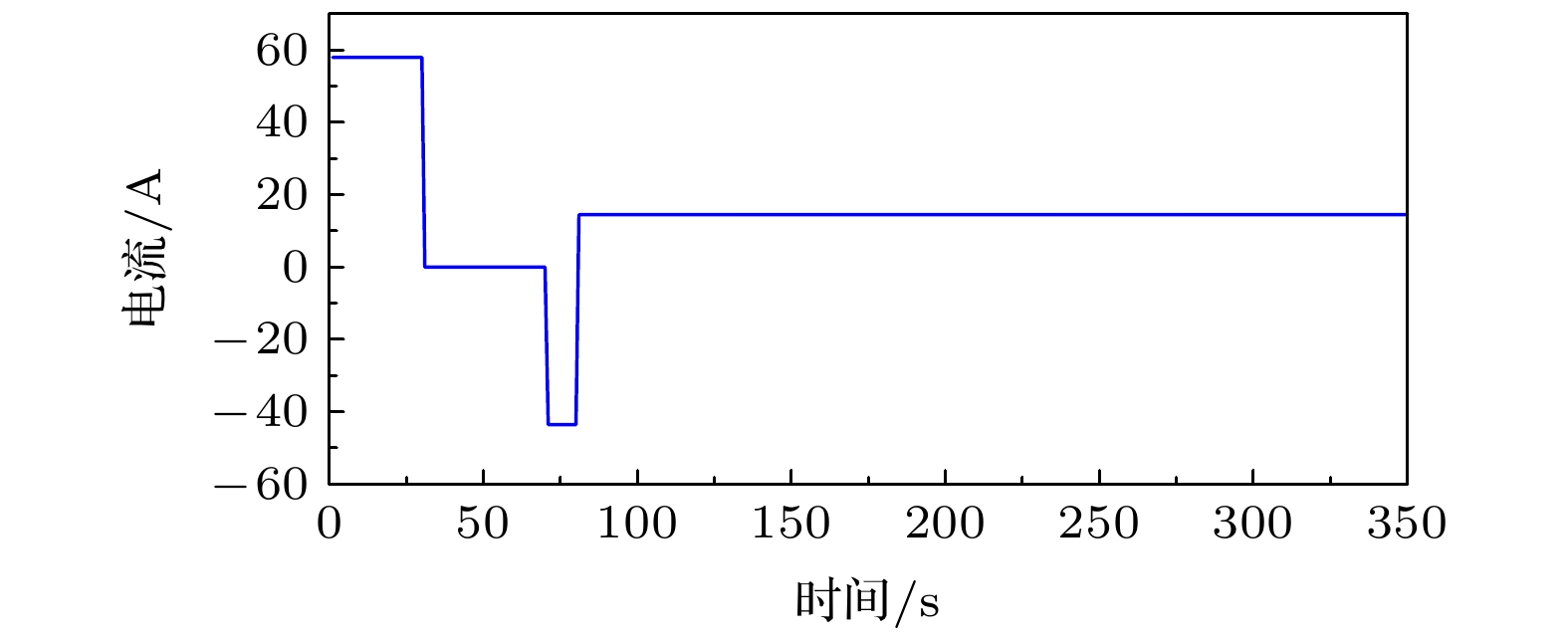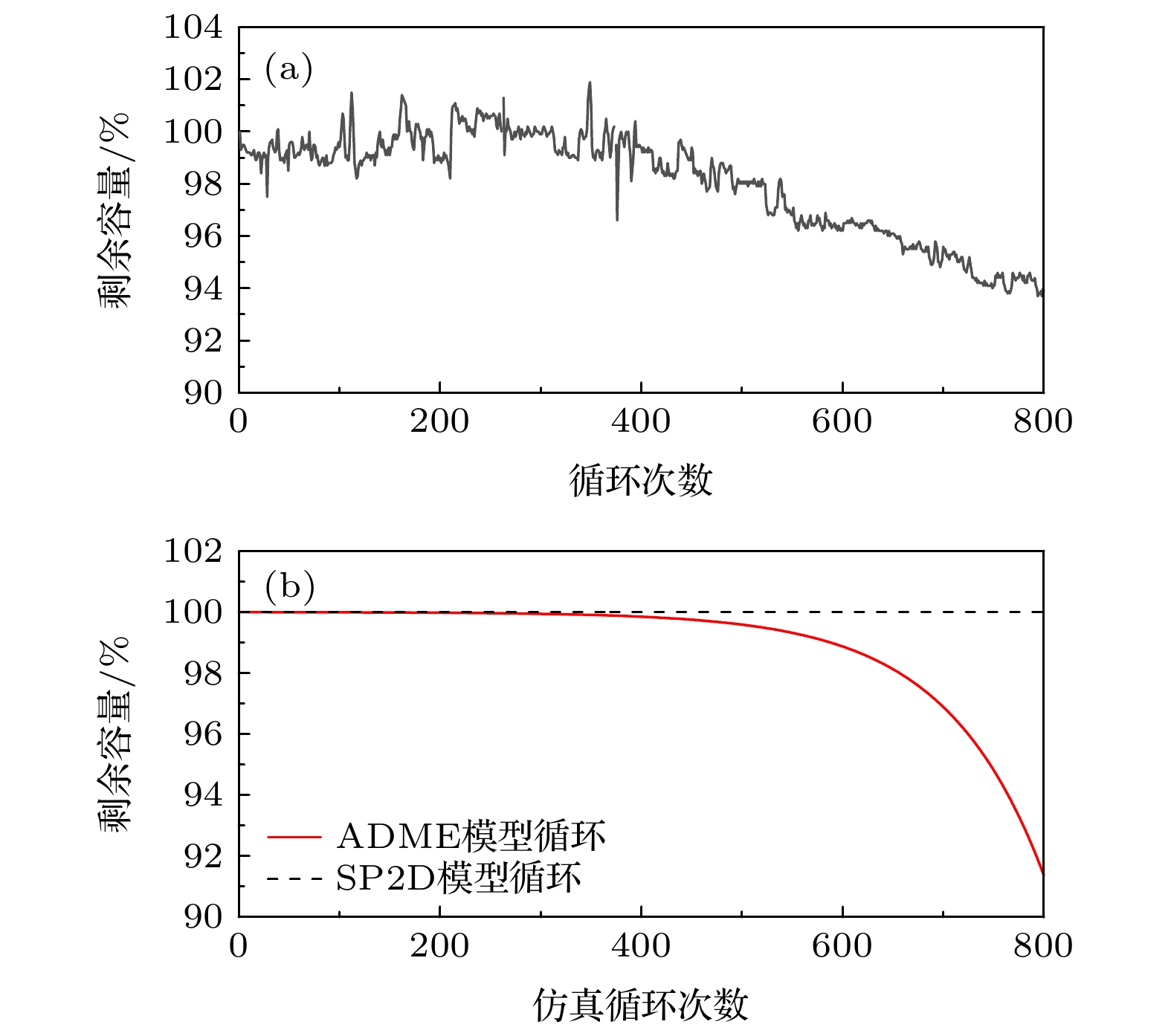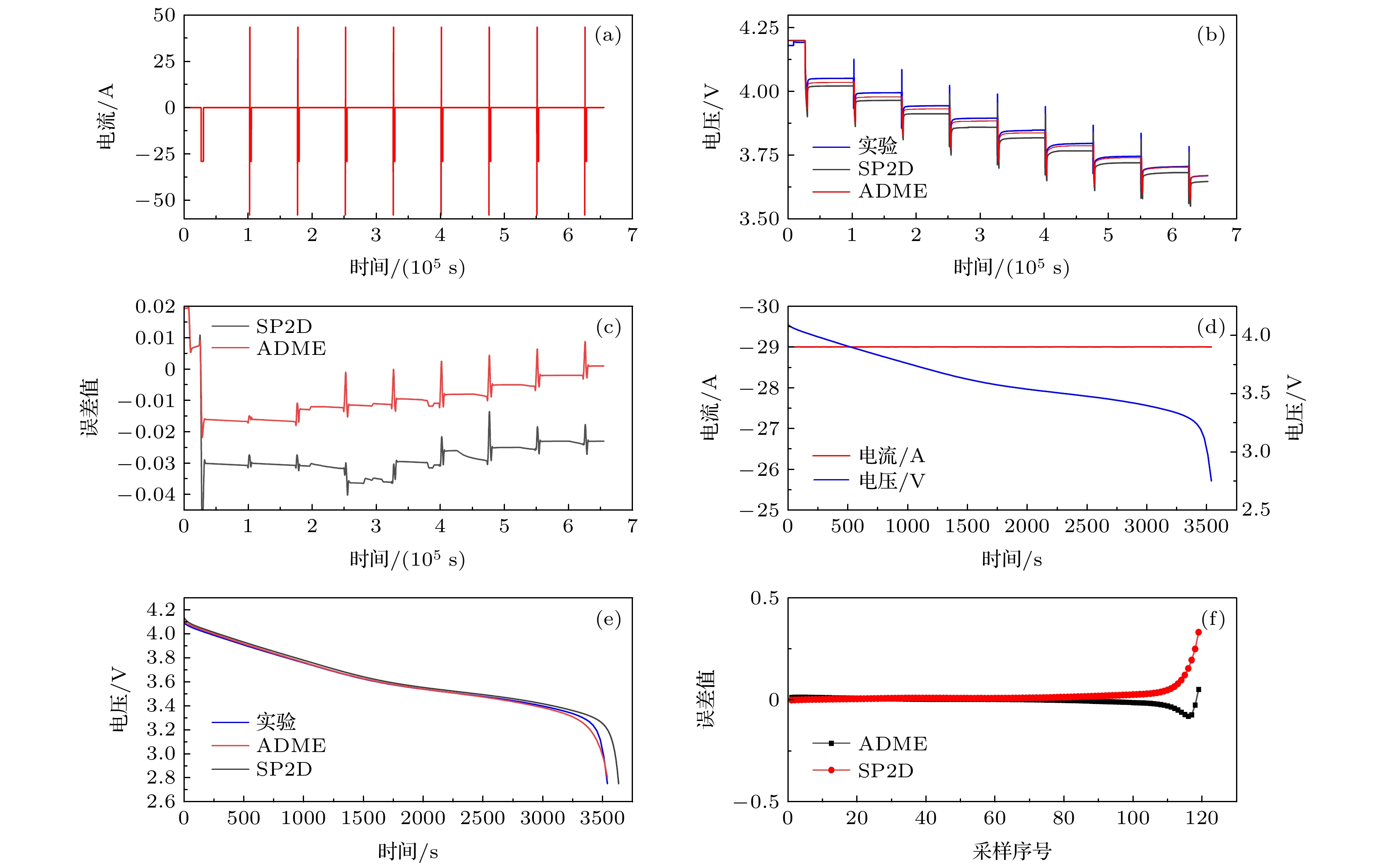-
The current electrochemical models of lithium-ion power batteries have many problems, such as complex models, difficult modeling, low computational efficiency and poor aging evaluation effect. In this paper, a mechanism model (ADME) considering battery decay and aging is proposed. In this paper, the pseudo-two-dimensions (P2D) electrochemical model is first reduced by finite difference method to obtain a simplified P2D (SP2D). On the basis of SP2D model, a mechanism model considering battery decay and aging is proposed, which is based on the degradation and aging phenomenon caused by the side reactions between positive and negative electrodes. Secondly, the multivariate deviation compensation least square method is used to identify the model parameters. Finally, the terminal voltage output of SP2D model is compared with that of ADME model and the outputs from the two models are also analyzed through the cycle experiment on power battery aging performance, constant current and pulse condition. The results show that the ADME model is relatively simple, has high computational efficiency and estimation accuracy, and can effectively evaluate the aging decline of battery capacity, and obtain the ideal external characteristic curve of lithium ion power battery.
[1] 刘征宇, 杨昆, 魏自红, 姚利阳 2019 物理学报 68 098801
 Google Scholar
Google Scholar
Liu Z Y, Yang K, Wei Z H, Yao L Y 2019 Acta Phys. Sin. 68 098801
 Google Scholar
Google Scholar
[2] Wei Z B, Meng S J, Xiong B Y, Ji D X, Tseng K J 2016 Appl. Energy 181 332
 Google Scholar
Google Scholar
[3] How D N T, Hannan M A, Lipu M S H, Ker P J 2019 IEEE Access 7 136116
 Google Scholar
Google Scholar
[4] 聂文亮, 谭伟杰, 邱刚, 李春莉, 聂祥飞 2018 中国电机工程学 38 5415
 Google Scholar
Google Scholar
Nie W L, Tan W J, Qiu G, Li C L, Nie X F 2018 Proc. Chin. Soc. Electr. Eng. 38 5415
 Google Scholar
Google Scholar
[5] Li X Y, Wang Z P, Zhang L 2019 Energy 174 33
 Google Scholar
Google Scholar
[6] Goh T, Park M, Seo M, Kim J G, Kim S W 2018 Energy 159 61
 Google Scholar
Google Scholar
[7] Hsieh Y C, Chiu Y C, Wu W T, Huang Y C 2019 IET Power Electron. 12 3085
 Google Scholar
Google Scholar
[8] Doyle M, Fuller T F, Newman J 1993 J. Electrochem. Soc. 140 1526
 Google Scholar
Google Scholar
[9] 曾建邦, 郭雪莹, 刘立超, 沈祖英, 单丰武, 罗玉峰 2019 物理学报 68 018201
 Google Scholar
Google Scholar
Zeng J B, Guo X Y, Liu L C, Shen Z Y, Shan F W, Luo Y F 2019 Acta Phys. Sin. 68 018201
 Google Scholar
Google Scholar
[10] Pang H, Mou L J, Guo L, Zhang F Q 2019 Electrochim. Acta 307 474
 Google Scholar
Google Scholar
[11] Lotfi N, Li J, Landers R G, Park J 2017 American Control Conference Seattle, USA, May 24–26, 2017 p86
[12] Gambhire P, Hariharan K S, Khandelwal A, Kolake S M, Yeo T, Doo S 2014 J. Power Sources 270 281
 Google Scholar
Google Scholar
[13] 庞辉, 张旭 2018 物理学报 67 228201
 Google Scholar
Google Scholar
Pang H, Zhang X 2018 Acta Phys. Sin. 67 228201
 Google Scholar
Google Scholar
[14] Jokar A, Rajabloo B, Désilets M, Lacroix M 2016 J. Power Sources 327 44
 Google Scholar
Google Scholar
[15] 袁世斐, 吴红杰, 殷承良 2017 浙江大学学报(工学版) 51 478
 Google Scholar
Google Scholar
Yuan S F, Wu H J, Yin C L 2017 J. Zhejiang Univ. (Eng. Sci. ) 51 478
 Google Scholar
Google Scholar
[16] 黄亮, 李建远 2015 物理学报 64 108202
 Google Scholar
Google Scholar
Huang L, Li J Y 2015 Acta Phys. Sin. 64 108202
 Google Scholar
Google Scholar
[17] Li J F, Lai Q Z, Wang L X, Lyu C, Wang H 2016 Energy 114 1226
 Google Scholar
Google Scholar
[18] Lyu C, Zhao Y, Luo W, Wang L 2019 14th IEEE Conference on Industrial Electronics and Applications (ICIEA) Xi’an, China, Jun 19–21, 2019 p2418
[19] Smith K, Shi Y, Santhanagopalan S 2015 American Control Conference Chicago, USA, July 1–3, 2015 p728
[20] 熊瑞 2018 动力电池管理系统核心算法 (北京: 机械工业出版社) 第41页
Xiong R 2018 Core Algorithm of Battery Management System for Evs (Beijing: Machinery Industry Press) p41 (in Chinese)
[21] Broussely M, Biensan P, Bonhomme F, Blanchard P, Herreyre S, Nechev K, Staniewicz R J 2005 J. Power Sources 146 90
 Google Scholar
Google Scholar
[22] Inoue G K S, Hirota K T T, Kamiya Y, Daisho Y, Inami S 2013 World Electric Vehicle Symposium and Exhibition (EVS27) Barcelona, Spain, November 17–20, 2013 p555
[23] 林树坤, 卢荣 2016 物理化学 (武汉: 华中科技大学出版社) 第160页
Lin S K, Lu R 2016 Physical Chemical (2nd Ed.) (Wuhan: Huazhong University of Science and Technology Press) p160 (in Chinese)
[24] Marcicki J, Todeschini F, Onori S, Canova M 2012 American Control Conference Fairmont Queen Elizabeth Montréal, Canada, June 27–29, 2012 p572
[25] 庞辉 2018 物理学报 67 058201
 Google Scholar
Google Scholar
Pang H 2018 Acta Phys. Sin. 67 058201
 Google Scholar
Google Scholar
[26] Wu H J, Yuan S F, Zhang X, Yin C L, Ma X R 2015 J. Power Sources 287 108
 Google Scholar
Google Scholar
[27] 张勇, 杨慧中 2007 自动化学报 10 1053
 Google Scholar
Google Scholar
Zhang Y, Yang H Z 2007 Acta Autom. Sin. 10 1053
 Google Scholar
Google Scholar
[28] 陈息坤, 孙冬 2016 中国电机工程学报 36 6254
 Google Scholar
Google Scholar
Chen X K, Sun D 2016 Proc. Chin. Soc. Electr. Eng. 36 6254
 Google Scholar
Google Scholar
-
表 1 模型参数及相关物理意义
Table 1. Model parameters and their physical meanings.
参数 物理意义 参数 物理意义 $ { \varepsilon }_{{\rm{e}}} $ 液相体积分数 $ {\alpha }_{{\rm{a}}} $ 阳极传递系数, 通常取0.5 $ {c}_{{\rm{e}}} $ 液相锂离子浓度 $ {\alpha }_{{\rm{c}}} $ 阴极传递系数, 通常取0.5 x 极板厚度 η 球形颗粒表面过电势 $ {D}_{{\rm{e}}}^{{\rm{e}}{\rm{f}}{\rm{f}}} $ 锂离子液相有效扩散系数 $ {k}_{{\rm{s}}} $ 电化学反应常数 a 电极颗粒单位体积 $ {t}_{{\rm{K}}} $ 载流子的迁移数 $ {t}_{+}^{0} $ 锂离子液相转移系数 $ {c}_{{\rm{s}}, {\rm{m}}{\rm{a}}{\rm{x}}} $ 活性材料内锂离子浓度最大值 $ {j}_{{\rm{r}}} $ 固相-液相交界面处的锂离子流量密度 $ {c}_{{\rm{s}}{\rm{u}}{\rm{r}}{\rm{f}}} $ 固相-液相交界面处的锂离子浓度 $ {c}_{{\rm{s}}} $ 固相锂离子浓度 $ {U}_{{\rm{t}}} $ 动力电池端电压 r 固体球形颗粒的半径方向 $ {D}_{{\rm{e}}{\rm{f}}} $ 固体电解质界面膜锂离子液相扩散系数 $ {D}_{{\rm{s}}} $ 锂离子固相扩散系数 $ {\kappa }_{{\rm{e}}{\rm{f}}} $ 固体电解质界面膜液相有效离子电导率 $ {R}_{{\rm{s}}} $ 固相活性颗粒半径 $ {c}_{{\rm{e}}{\rm{f}}} $ 固体电解质界面膜锂离子浓度 $ {\kappa }^{{\rm{e}}{\rm{f}}{\rm{f}}} $ 液相有效离子电导率 $ {\kappa }_{{\rm{e}}{\rm{f}}}^{{\rm{D}}} $ 固体电解质界面膜有效离子电导率 $ { \phi }_{{\rm{e}}} $ 液相势能 $ { \phi }_{{\rm{e}}{\rm{f}}} $ 固体电解质界面膜电势 R 摩尔气体常数 $ {j}_{{\rm{a}}}^{{\rm{s}}} $ 副反应阳极电流密度 T 电池温度 $ {a}_{{\rm{s}}, {\rm{a}}}^{{\rm{s}}} $ 副反应阳极活性颗粒比表面积 F 法拉第常数 $ {i}_{0, {\rm{a}}}^{{\rm{s}}} $ 副反应阳极初始电流密度 $ {i}_{{\rm{e}}} $ 液相电流密度 $ {\alpha }_{{\rm{a}}}^{{\rm{s}}} $ 副反应阳极锂离子传递系数 $ {\sigma }^{{\rm{e}}{\rm{f}}{\rm{f}}} $ 固相有效扩散电导率 $ {j}_{{\rm{c}}}^{{\rm{s}}} $ 副反应阴极电流密度 $ { \phi }_{{\rm{s}}} $ 固相势能 $ {a}_{{\rm{s}}, {\rm{c}}}^{{\rm{s}}} $ 副反应阴极活性颗粒比表面积 $ {i}_{{\rm{s}}} $ 固相电流密度 $ {i}_{0, {\rm{c}}}^{{\rm{s}}} $ 副反应阴极初始电流密度 i 锂离子电池充放电电流密度 $ {\alpha }_{{\rm{c}}}^{{\rm{s}}} $ 副反应阴极锂离子传递系数 $ {a}_{{\rm{s}}} $ 活性颗粒比表面积 $ {U}_{{\rm{c}}}^{{\rm{s}}} $ 副反应端电压 $ { \varepsilon }_{{\rm{s}}} $ 固相体积分数 $ {\delta }_{{\rm{e}}{\rm{f}}, {\rm{a}}} $ 固体电解质界面膜厚度 $ {i}_{{\rm{l}}} $ 外部电流大小 $ {M}^{{\rm{s}}} $ 副反应产物分子量 S 电极有效面积 $ {\rho }^{{\rm{s}}} $ 副反应产物密度 n 锂离子电荷数 $ { \varepsilon }_{{\rm{e}}{\rm{f}}, {\rm{c}}} $ 膜孔隙率 $ {i}_{0} $ 交换电流密度 $ {R}_{{\rm{f}}} $ 接触电阻 -
[1] 刘征宇, 杨昆, 魏自红, 姚利阳 2019 物理学报 68 098801
 Google Scholar
Google Scholar
Liu Z Y, Yang K, Wei Z H, Yao L Y 2019 Acta Phys. Sin. 68 098801
 Google Scholar
Google Scholar
[2] Wei Z B, Meng S J, Xiong B Y, Ji D X, Tseng K J 2016 Appl. Energy 181 332
 Google Scholar
Google Scholar
[3] How D N T, Hannan M A, Lipu M S H, Ker P J 2019 IEEE Access 7 136116
 Google Scholar
Google Scholar
[4] 聂文亮, 谭伟杰, 邱刚, 李春莉, 聂祥飞 2018 中国电机工程学 38 5415
 Google Scholar
Google Scholar
Nie W L, Tan W J, Qiu G, Li C L, Nie X F 2018 Proc. Chin. Soc. Electr. Eng. 38 5415
 Google Scholar
Google Scholar
[5] Li X Y, Wang Z P, Zhang L 2019 Energy 174 33
 Google Scholar
Google Scholar
[6] Goh T, Park M, Seo M, Kim J G, Kim S W 2018 Energy 159 61
 Google Scholar
Google Scholar
[7] Hsieh Y C, Chiu Y C, Wu W T, Huang Y C 2019 IET Power Electron. 12 3085
 Google Scholar
Google Scholar
[8] Doyle M, Fuller T F, Newman J 1993 J. Electrochem. Soc. 140 1526
 Google Scholar
Google Scholar
[9] 曾建邦, 郭雪莹, 刘立超, 沈祖英, 单丰武, 罗玉峰 2019 物理学报 68 018201
 Google Scholar
Google Scholar
Zeng J B, Guo X Y, Liu L C, Shen Z Y, Shan F W, Luo Y F 2019 Acta Phys. Sin. 68 018201
 Google Scholar
Google Scholar
[10] Pang H, Mou L J, Guo L, Zhang F Q 2019 Electrochim. Acta 307 474
 Google Scholar
Google Scholar
[11] Lotfi N, Li J, Landers R G, Park J 2017 American Control Conference Seattle, USA, May 24–26, 2017 p86
[12] Gambhire P, Hariharan K S, Khandelwal A, Kolake S M, Yeo T, Doo S 2014 J. Power Sources 270 281
 Google Scholar
Google Scholar
[13] 庞辉, 张旭 2018 物理学报 67 228201
 Google Scholar
Google Scholar
Pang H, Zhang X 2018 Acta Phys. Sin. 67 228201
 Google Scholar
Google Scholar
[14] Jokar A, Rajabloo B, Désilets M, Lacroix M 2016 J. Power Sources 327 44
 Google Scholar
Google Scholar
[15] 袁世斐, 吴红杰, 殷承良 2017 浙江大学学报(工学版) 51 478
 Google Scholar
Google Scholar
Yuan S F, Wu H J, Yin C L 2017 J. Zhejiang Univ. (Eng. Sci. ) 51 478
 Google Scholar
Google Scholar
[16] 黄亮, 李建远 2015 物理学报 64 108202
 Google Scholar
Google Scholar
Huang L, Li J Y 2015 Acta Phys. Sin. 64 108202
 Google Scholar
Google Scholar
[17] Li J F, Lai Q Z, Wang L X, Lyu C, Wang H 2016 Energy 114 1226
 Google Scholar
Google Scholar
[18] Lyu C, Zhao Y, Luo W, Wang L 2019 14th IEEE Conference on Industrial Electronics and Applications (ICIEA) Xi’an, China, Jun 19–21, 2019 p2418
[19] Smith K, Shi Y, Santhanagopalan S 2015 American Control Conference Chicago, USA, July 1–3, 2015 p728
[20] 熊瑞 2018 动力电池管理系统核心算法 (北京: 机械工业出版社) 第41页
Xiong R 2018 Core Algorithm of Battery Management System for Evs (Beijing: Machinery Industry Press) p41 (in Chinese)
[21] Broussely M, Biensan P, Bonhomme F, Blanchard P, Herreyre S, Nechev K, Staniewicz R J 2005 J. Power Sources 146 90
 Google Scholar
Google Scholar
[22] Inoue G K S, Hirota K T T, Kamiya Y, Daisho Y, Inami S 2013 World Electric Vehicle Symposium and Exhibition (EVS27) Barcelona, Spain, November 17–20, 2013 p555
[23] 林树坤, 卢荣 2016 物理化学 (武汉: 华中科技大学出版社) 第160页
Lin S K, Lu R 2016 Physical Chemical (2nd Ed.) (Wuhan: Huazhong University of Science and Technology Press) p160 (in Chinese)
[24] Marcicki J, Todeschini F, Onori S, Canova M 2012 American Control Conference Fairmont Queen Elizabeth Montréal, Canada, June 27–29, 2012 p572
[25] 庞辉 2018 物理学报 67 058201
 Google Scholar
Google Scholar
Pang H 2018 Acta Phys. Sin. 67 058201
 Google Scholar
Google Scholar
[26] Wu H J, Yuan S F, Zhang X, Yin C L, Ma X R 2015 J. Power Sources 287 108
 Google Scholar
Google Scholar
[27] 张勇, 杨慧中 2007 自动化学报 10 1053
 Google Scholar
Google Scholar
Zhang Y, Yang H Z 2007 Acta Autom. Sin. 10 1053
 Google Scholar
Google Scholar
[28] 陈息坤, 孙冬 2016 中国电机工程学报 36 6254
 Google Scholar
Google Scholar
Chen X K, Sun D 2016 Proc. Chin. Soc. Electr. Eng. 36 6254
 Google Scholar
Google Scholar
Catalog
Metrics
- Abstract views: 14303
- PDF Downloads: 270
- Cited By: 0















 DownLoad:
DownLoad:





